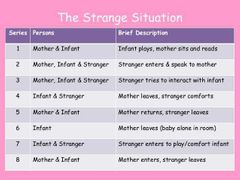![]()
![]()
![]()
Use LEFT and RIGHT arrow keys to navigate between flashcards;
Use UP and DOWN arrow keys to flip the card;
H to show hint;
A reads text to speech;
31 Cards in this Set
- Front
- Back
|
Includes those stable psychological characteristics that make each human being unique |
Personality |
|
|
Are typically egocentric and are primarily concerned with satisfying physical desires, such as hunger |
Infants |
|
|
According to Freud too little or too much stimulation of a particular erogenous zone at a particular psychosexual stage of development leads to what |
fixation |
|
|
This perspective says that girls are better adjusted psychosocially than boys. Girls become extensions of their mothers; as a result, girls do not need to separate from their mothers. Boys, on the other. must separate from their mothers to become independent |
Melanie Klein'S Object-Relations Theory (OBT) |
|
|
Is the process whereby one individual seeks nearness to another individual |
Attachment |
|
|
He suggests that infants are born preprogrammed for certain behaviours that guarantee bonding with their caregivers |
John Bowlby |
|
|
Is the connection a baby forms with its parent to ensure their basic needs of safety, comfort, care and pleasure are met |
Attachment |
|
|
Examples of long-term consequences of maternal deprivation (5) |
Delinquency Reduced intelligence Increased aggression Depression Affectionless Psychopath |
|
|
The child’s attachment relationship with their primary caregiver leads to what |
Development of an internal working model |
|
|
Bowlby’s PDD Model (3) |
Protest Despair Detachment |
|
|
The child cries, screams and ______ angrily when the parent leaves. They will try to cling on to the parent to stop them leaving |
Protest |
|
|
The child’s protesting begins to stop, and they appear to be calmer although still upset. The child refuses others’ attempts for comfort and often seems withdrawn and uninterested in anything |
Despair |
|
|
If separation continues the child will start to engage with other people again. They will reject the caregiver on their return and show strong signs of anger |
Detachment |
|
|
Bowlby’s Stages of Attachment (4) |
1.) Preattachment Phase (birth – 6 weeks) 2.) Attachment in Making Phase (6 weeks to 6-8 months) 3.) Clear Cut Attachment (6-8 months to 18 months – 2 yrs) 4.) Formation of reciprocal relationship (18 months- to years +) |
|
|
Newborn infants know to act in such a way that attracts adults, such as crying, smiling, cooing, and making eye contact. Although not attached to their mothers yet, they are soothed by the presence of others |
Preattachment Phase (birth – 6 weeks) |
|
|
Infants begins to develop a sense of trust in their mothers, in that they can depend on her in times of need. They are soothed more quickly by their mother, and smile more often next to her |
Attachment in Making Phase (6 weeks to 6-8 months) |
|
|
Attachment is established. The infant prefers his mother over anyone else, and experiences separation anxiety when she leaves. The intensity of separation anxiety is influenced by the infant’s temperament and the way in which caregivers respond and soothe the infant |
Clear Cut Attachment (6-8 months to 18 months – 2 yrs) |
|
|
As language develops, separation anxiety declines. The infant can now understand when his mother is leaving and when she will be coming back. In addition, a sense of security has developed, in that even when his mother is not physically there, he knows she is always there for him |
Formation of reciprocal relationship (18 months- to years +): |
|
|
Basic Concepts of the Attachment Styles of Mary Ainsworth |

|
|
|
Attachment Type (4) |
Secure Insecure-avoidant Insecure-ambivalent Insecure-disorganized |
|

|
Secure |
|

|
Insecure-avoidant |
|

|
Insecure-ambivalent |
|

|
Insecure disorganized |
|
|
Distress at the prospect of being left alone in an unfamiliar place |
Separation Anxiety |
|
|
Distress in the presence of unfamiliar people |
Stranger anxiety |
|
|
Absence of attachment or reduction of culturally normal interaction between an individual and the rest of society |
Social Deprivation |
|
|
Genetics, prenatal and postnatal hormones, differences in the brain and the reproductive organs, and socialization all interact to mold a toddler's ______? |
Gender Identity |
|
|
Plays a significant role in the establishment of her or his sense of femaleness or maleness |
Gender socialization |
|
|
Deeply embedded cognitive frameworks regarding what defines masculine and feminine |
Gender Schema |
|
|
Educators, peers, movies, television, music, books, and religion—teach and reinforce gender roles throughout a child's life span |
Socializing agents |

